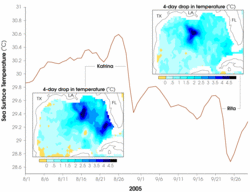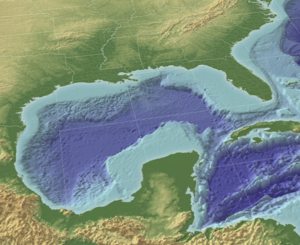Gulf of Mexico
2007 Schools Wikipedia Selection. Related subjects: General Geography
The Gulf of Mexico is a major body of water bordered and nearly landlocked by North America.
Principal features
The gulf's eastern, north, and northwestern shores lie within the United States of America (specifically, the states of Florida, Alabama, Mississippi, Louisiana, and Texas); its southwestern and southern shores lie within Mexico (specifically, the states of Tamaulipas, Veracruz, Tabasco, Campeche, Yucatán, and Quintana Roo); on the southeast it is bordered by Cuba. It connects with the Atlantic Ocean via the Florida Straits between the U.S. and Cuba, and with the Caribbean Sea (with which it forms the American Mediterranean Sea) via the Yucatan Channel between Mexico and Cuba.
In the United States, the term " Gulf Coast" usually refers to either the continuous portion of the coast running from Cape Sable, Florida, to Brownsville, Texas, or from Cape Sable, Florida, to the northern tip of the Yucatán Peninsula at Cabo Catoche, Quintana Roo. Both meanings exclude Cuba as well as the Florida Keys.
The total area of the Gulf of Mexico is approximately 615,000 mi² (1.6 million km²), the southern third of which lies within the tropics, and plunges to a depth of 2,080 fathoms (3804 m). This deepest part is Sigsbee Deep, an irregular trough more than 300 nautical miles (550 km) long, sometimes called the "Grand Canyon under the sea." The cooler water from the deep stimulates plankton growth, which attracts small fish, shrimp, and squid.
The Gulf Stream, a warm Atlantic Ocean current and one of the strongest ocean currents known, originates in the gulf, as a continuation of the Caribbean Current-Yucatán Current- Loop Current system. Other circulation features include the anticyclonic gyres which are shed by the Loop Current and travel westward where they eventually dissipate, and a permanent cyclonic gyre in the Bay of Campeche.

Because of the gulf's general warm temperatures, it has been visited many times by powerful Atlantic hurricanes, some of which have caused extensive human death and other destruction (see 2005's Hurricane Katrina, for example). In the Atlantic, a hurricane will draw up cool water from the depths and making it less likely that further hurricanes will follow in its wake (warm water being one of the preconditions necessary for their formation). However, the Gulf is shallower and its entire water column is warm. When a hurricane passes over, although the water temperature may drop it soon rebounds and becomes capable of supporting another tropical storm.
Tidal ranges are extremely small in the Gulf of Mexico due to the narrow connection with the ocean – much like the Mediterranean.
The Bay of Campeche in Mexico constitutes a major arm of the Gulf of Mexico. Additionally, the gulf's shoreline is fringed by numerous bays and smaller inlets. A number of rivers empty into the gulf, most notably the Mississippi Riverin the northern gulf, and the Grijalva and Usumacinta Rivers in the southern gulf. The land that forms the gulf's coast, including many long, narrow barrier islands, is almost uniformly low-lying and is characterized by marshes and swamps as well as stretches of sandy beach.
The continental shelf is quite wide at most points along the coast, most notably at the Florida and Yucatán Peninsulas. The shelf is exploited for its oil by means of offshore drilling rigs, most of which are situated in the western gulf and in the Bay of Campeche. Another important commercial activity is fishing; major catches include red snapper, amberjack, tilefish, swordfish, and various grouper, as well as shrimp and crabs. Oysters are also harvested on a large scale from many of the bays and sounds. Other important industries along the coast include shipping, petrochemical processing and storage, paper manufacture, and tourism.
Coastal cities of note include Biloxi, Gulfport, Tampa, St. Petersburg, Pensacola, Mobile, New Orleans, Galveston, Beaumont, and Houston (all in the U.S.), Tampico, Tuxpam, Veracruz and Campeche (in Mexico), and Havana (in Cuba).
The gulf's coastal areas were first settled by Native American groups, including those representing several of the early advanced cultures of Mexico. During the period of European exploration and colonization the entire region became a theatre of contention between the Spanish, French and English. The present-day culture of the coastal region is primarily Spanish-American (Mexico, Cuba) and Anglo-American (U.S.).
A point of interest about the Gulf is that 65 million years ago, the Chicxulub crater was formed when a large meteorite hit the earth. It is hypothesized that this impact was the asteroid that caused the extinction of the non-avian dinosaurs.
Pollution
Because of the ever increasing amount of nitrogen and phosphates dissolved in the waters of the Gulf of Mexico, pollution has more than doubled since 1950. Current estimates suggest that three times as much nitrogen is being carried into the Gulf today compared with levels 30 years ago or at any time in history. Blooms of photosynthesizers die and sink, and the processes of their decay exhausts the available supplies of oxygen dissolved in the water. Every summer there is now an area south of the Louisiana coastline, larger than the U.S. state of Massachusetts at over 7,000 mi² (18,000 km²) that is hypoxic. These waters do not carry enough oxygen to sustain marine life. This annually enlarging dead zone is a major threat to the fishing industry and to public health.
Also, there are frequent " red tide" algae blooms that kill fish and marine mammals and cause respiratory problems in humans and some domestic animals when the blooms reach close to shore. This has especially been plaguing the southwest Florida coast, from the Florida Keys to north of Pasco County, Florida.
Seismic activity
The Gulf is considered aseismic: however, mild tremors have been recorded throughout history (usually 5.0 or less on the Richter scale). A 6.0 tremor was recorded on September 10, 2006, 250 miles off the coast of Florida which caused no damage, but could be felt throughout the Southeastern United States. No damage or injuries were reported. Earthquakes such as this may be caused by interactions between sediment loading on the sea floor and adjustment by the crust.


